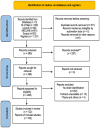Systematic review of literature to evaluate global distribution of species of the Sporothrix genus stored in culture collections
- PMID: 38828263
- PMCID: PMC11140055
- DOI: 10.3389/fcimb.2024.1382508
Systematic review of literature to evaluate global distribution of species of the Sporothrix genus stored in culture collections
Abstract
Introduction: Sporotrichosis is a subcutaneous mycosis caused by fungi of the genus Sporothrix sp. Phenotypic and genotypic differences have been associated with their geographic distribution, virulence, or clinical manifestation of sporotrichosis. In the past decade, the interest in identifying species of the Sporothrix sp. has been increasing, due to its epidemiological importance and, in consequence, is important to know how to preserve them for future studies, in culture collection.
Aims: The purposes of this study were to analyze the global distribution of environmental isolates and/or causal agents of sporotrichosis identified by polyphasic taxonomy, with mandatory use of molecular identification, and to evaluate the percentages and distribution of isolates stored in culture collections.
Methods: A systematic review of articles on animal and human sporotrichosis and/or environmental isolation of the fungus, from 2007 to 2023, was done. Results: Our results demonstrated that, S. globosa, S. schenckii, and S. brasiliensis were the most identified species. With respect to the deposit and maintenance of species, we observed that only 17% of the strains of Sporothrix sp. isolated in the world are preserved in a culture collection.
Conclusions: This systematic review confirmed a difficulty in obtaining the frequency of Sporothrix species stored in culture collection and insufficient data on the molecular identification mainly of animal sporotrichosis and isolation of Sporothrix sp. in environmental samples.
Keywords: Sporothrix sp; culture collections; polyphasic taxonomy; preservation; sporotrichosis; systematic review.
Copyright © 2024 Morgado, Castro, Ribeiro-Alves, Corrêa-Moreira, Silva, Menezes and Oliveira.
Conflict of interest statement
The authors declare that the research was conducted in the absence of any commercial or financial relationships that could be construed as a potential conflict of interest.
Figures


Similar articles
-
Zoonotic sporotrichosis: Systematic review and clinical aspects of feline and canine cases.Med Mycol. 2025 Jul 2;63(7):myaf060. doi: 10.1093/mmy/myaf060. Med Mycol. 2025. PMID: 40705328
-
The Historical Burden of Sporotrichosis in Brazil: a Systematic Review of Cases Reported from 1907 to 2020.Braz J Microbiol. 2022 Mar;53(1):231-244. doi: 10.1007/s42770-021-00658-1. Epub 2021 Nov 26. Braz J Microbiol. 2022. PMID: 34825345 Free PMC article.
-
Targeted long-read sequencing analysis and antifungal susceptibility profiles of Sporothrix schenckii isolates from Thailand.PLoS Negl Trop Dis. 2025 Jun 30;19(6):e0013253. doi: 10.1371/journal.pntd.0013253. eCollection 2025 Jun. PLoS Negl Trop Dis. 2025. PMID: 40587582 Free PMC article.
-
Cat-transmitted sporotrichosis by Sporothrix brasiliensis: Focus on its potential transmission routes and epidemiological profile.Med Mycol. 2025 Jun 5;63(6):myaf051. doi: 10.1093/mmy/myaf051. Med Mycol. 2025. PMID: 40489322
-
A novel approach for feline sporotrichosis pathogen detection based on loop-mediated isothermal amplification.Vet Dermatol. 2025 Aug;36(4):474-484. doi: 10.1111/vde.13345. Epub 2025 Apr 21. Vet Dermatol. 2025. PMID: 40259669 Free PMC article.
References
-
- Alzuguir C. L. C., Pereira S. A., Magalhães M. A., Almeida-Paes R., Freitas D. F. S., Oliveira L. F. A., et al. . (2019). Geo-epidemiology and socioeconomic aspects of human sporotrichosis in the municipality of Duque de Caxias, Rio de Janeiro, Brazil, between 2007 and 2016. Trans. R. Soc. Trop. Med. Hygiene. 114, 81. doi: 10.1093/trstmh/trz081 - DOI - PubMed
-
- Boechat J. S., Oliveira M. M. E., Gremião I. D. F., Almeida-Paes R., MaChado A. C., Zancopé-Oliveira R., et al. . (2022). Sporothrix brasiliensis and Feline Sporotrichosis in the Metropolitan Region of Rio de Janeiro, Brazil, (1998-2018). J. Fungi (Basel). 8, 749. doi: 10.3390/jof8070749 - DOI - PMC - PubMed
Publication types
MeSH terms
LinkOut - more resources
Full Text Sources
Miscellaneous

